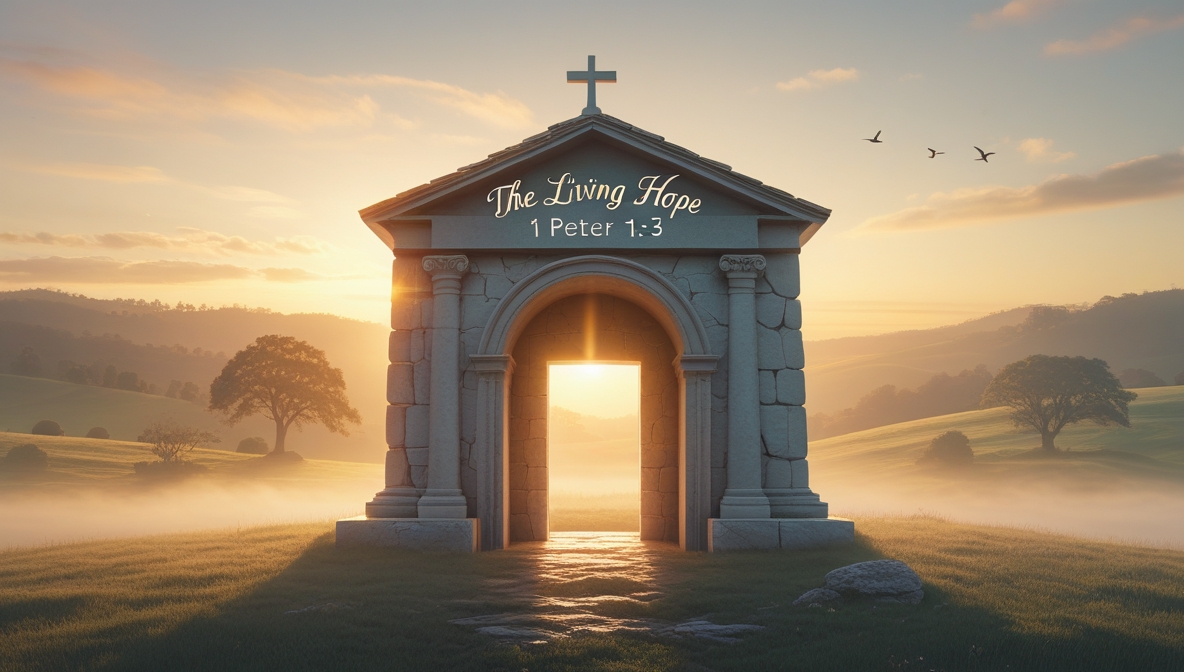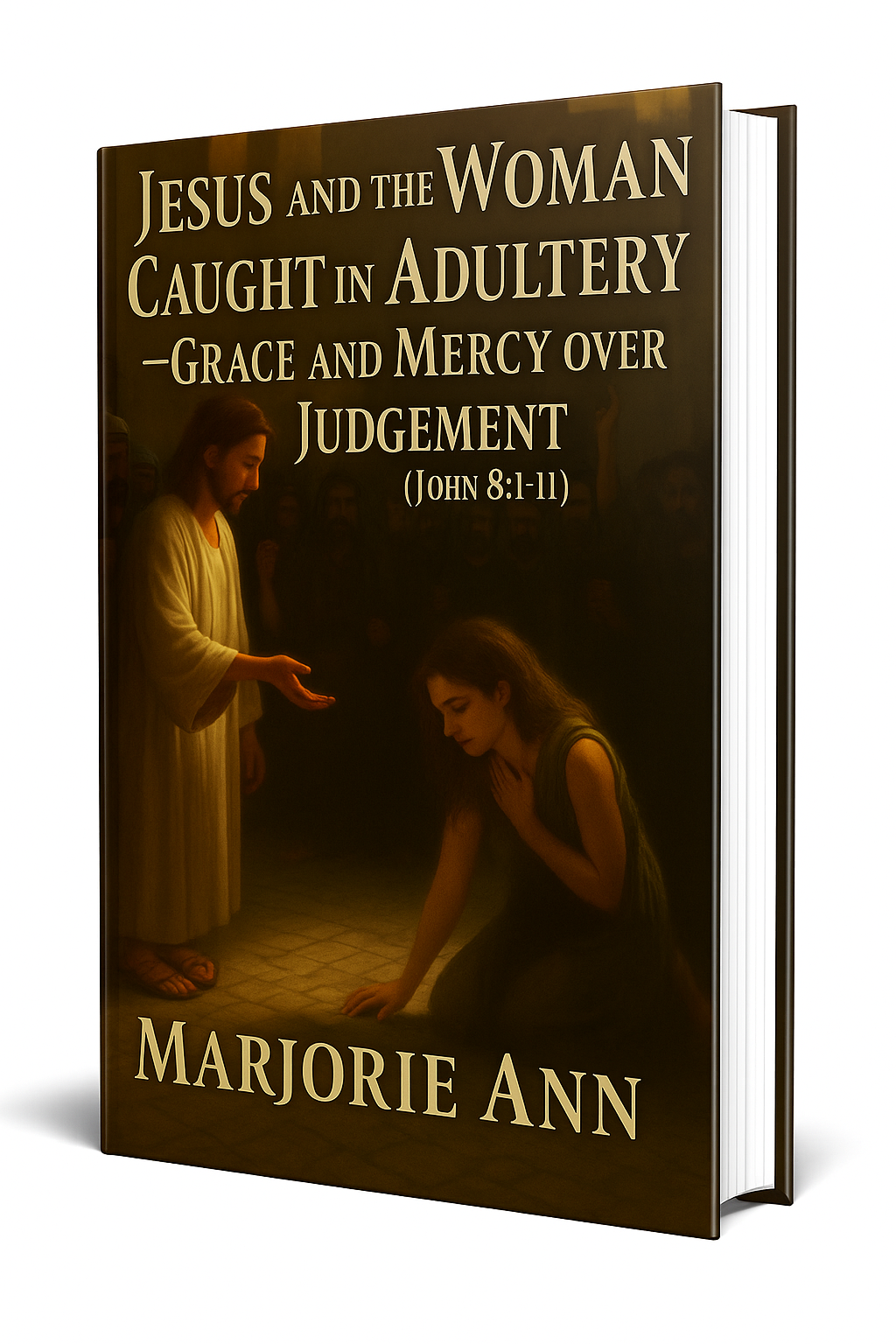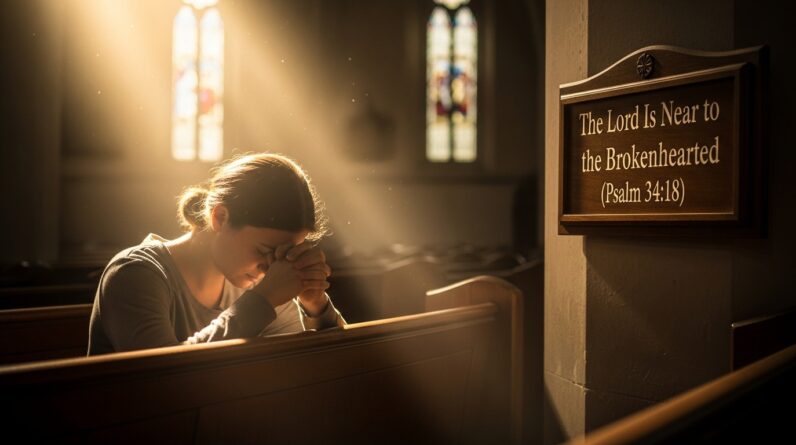The Living Hope (1 Peter 1:3)
You’ve probably heard the phrase “living hope” in sermons, hymns, and during quiet moments of prayer. It’s one of those biblical phrases that feels both comforting and heavy with meaning. When Peter writes about “the living hope” in 1 Peter 1:3, he’s pointing you to something anchored in history and oriented toward eternity — not a vague optimism, but a hope rooted in the resurrection of Jesus Christ. If you’re preparing or listening to “The Living Hope sermon,” this article will walk you through what that hope means, why it matters, how it helps you in suffering, and how it should shape daily Christian living.
For the core verse, see 1 Peter 1:3. Read it slowly and notice each phrase: God’s mercy, new birth, living hope, resurrection. Each piece is a door into deeper understanding.
What “living hope” means
You might think of hope as wishful thinking, but the New Testament uses “hope” in a weightier sense. “Living hope” suggests vitality and reality. It’s not a fragile candle; it’s a living source that continues to give light, direction, and purpose. When Peter calls it “living,” he contrasts it with dead or false hopes that fail when trials come.
Look carefully at the phrase in context in 1 Peter 1:3. Peter ties the living hope explicitly to the resurrection of Jesus from the dead. That connection matters: if Christ’s resurrection is true, then your hope is not abstract or temporary — it’s anchored in the decisive work God has done in history.
Biblical background for the phrase
The New Testament frames hope across various images: inheritance, redemption, waiting for the return of Christ, and resurrection life. In 1 Peter 1:3-5, Peter weaves those images together: mercy leading to new birth, living hope, an inheritance kept in heaven, and guarding by God’s power until salvation is revealed. That theological cluster shows you that hope for the believer is comprehensive — it affects identity, destiny, and assurance.
Other passages reinforce that resurrection is central. Paul links resurrection to new life in Christ and the basis for Christian hope in passages like Romans 6:4 and grounds the universal significance of Christ’s rising in 1 Corinthians 15:20-22. When you understand those links, “The Living Hope sermon” becomes a sermon about the ground of your trust, not just your feelings.
The context of 1 Peter
You won’t get the full force of “living hope” until you read Peter’s letter as a whole. He’s writing to Christians scattered across Asia Minor who are facing social pressure, slander, and possibly persecution. Peter’s purpose is pastoral: he wants to remind you who you are and where you belong in the light of Christ’s work. In 1 Peter 1:1-2, he addresses them as elect exiles — a phrase that already centers identity in God’s purposeful calling.
When you read verses like 1 Peter 1:6-7, you see why living hope is urgent. Trials are present, and the hope Peter proclaims is meant to sustain you through those trials, refining faith and leading to praise and glory when Christ is revealed. The letter’s immediate context is pastoral care for a persecuted community; the theological emphasis is firm assurance in the resurrected Christ.
The resurrection is the foundation
Peter doesn’t mention the resurrection casually. In 1 Peter 1:3 he explicitly links living hope to “the resurrection of Jesus Christ from the dead.” For your faith, that’s non-negotiable: without the resurrection, Christian hope collapses into wishful thinking. Paul makes the same point in 1 Corinthians 15:12-19, arguing that if Christ has not been raised, preaching and faith are in vain.
But Christ was raised. Historical and scriptural witnesses insist on it, and Peter’s pastoral point is practical: because Christ rose, you have a hope that is living, active, and final. The resurrection assures you that death is not the end and that God’s redemptive plan has already decisively entered history, giving you grounds to hope for a transformed future.
Core themes of “The Living Hope sermon”
When you prepare or listen to “The Living Hope sermon,” you’ll typically encounter several recurring themes: new birth, inheritance, assurance, joy in trials, and the ethical implications of hope. Each theme clarifies what hope looks like in the Christian life.
New birth: identity redefined
Peter says the living hope comes through God’s mercy and “into a living hope through the resurrection of Jesus Christ” to a new birth. The image of being born again shifts your identity from an outsider to a child of God. This new birth isn’t merely moral improvement; it’s a spiritual rebirth that changes your standing before God and your orientation toward eternity. Reflect on 1 Peter 1:3 and 1 Peter 1:23 to see how new birth shapes your understanding of Scripture and life.
This identity reframing matters when you face rejection or loneliness. You don’t base your worth on social approval or circumstances. Your identity is anchored in God’s mercy and a resurrected Lord, which gives you a stable platform from which to live and to love others.
An inheritance kept in heaven
Peter speaks of an inheritance “that can never perish, spoil or fade” and is kept in heaven for you (1 Peter 1:4-5). The imagery of inheritance conveys permanence, value, and promise. It tells you that your future is secure because God is guarding it. This is not the ephemeral reward of human accomplishments; it’s an imperishable inheritance grounded in God’s character and the resurrection.
When you hold this as true, your priorities shift. Earthly loss becomes temporary compared to what God has prepared. You’re freed to serve sacrificially because your reward is not threatened by human failure or decay.
Assurance: God’s power at work
One of the most comforting elements in Peter’s argument is assurance. He writes that you are “being guarded by God’s power” until the salvation ready to be revealed (1 Peter 1:5). That’s not your own fragile resolve doing the heavy lifting; it’s God’s power sustaining you. Assurance isn’t an internal, unbroken feeling but a theological conviction: God will complete what He has begun.
This assurance helps when doubt creeps in. You still wrestle with questions and dryness, but the promise that God preserves you sustains perseverance. Other passages like Romans 8:38-39 and Titus 3:7 echo this same confidence — God’s commitment to you is not tentative.
Joy in the midst of trials
Peter’s pastoral genius is to connect living hope with joy during suffering. He anticipates that trials will cause grief but reframes them as refining fire that proves the genuineness of your faith (1 Peter 1:6-7). That kind of joy isn’t a denial of pain; it’s a Gospel-shaped hope that sees suffering in the light of a larger, glory-filled future.
You can cultivate this joy honestly. James gives practical help when he exhorts believers to “consider it pure joy… whenever you face trials” because testing produces perseverance (James 1:2-4). The living hope doesn’t erase the ache — it provides meaning and an end goal.

How “The Living Hope sermon” shapes your spiritual life
If you let this sermon sink in, it will shape how you pray, worship, suffer, and engage others. The living hope is not abstract theology; it’s a living force that reorients your life.
Worship grounded in what Christ has done
Hope rooted in the resurrection leads you to worship that is grateful, sober, and forward-looking. You worship not to manipulate God but to respond to what He has already accomplished in Christ. Passages like Colossians 1:18 remind you that Christ is the head of the church and the firstborn from the dead, a central reason for corporate and private worship.
That kind of worship affects style and substance: you prioritize Christ-centered preaching, sacraments that point to the work of Christ, and liturgy that celebrates resurrection hope.
Suffering reframed — not meaningless, but meaningful
When suffering comes, living hope doesn’t give you a formula for removing it instantly, but it does provide purpose within it. You can approach pain with the question: How is this refining my faith? Peter’s theology suggests that trials can produce praise and glory when Christ is revealed (1 Peter 1:7). Paul echoes this idea when he says present sufferings are not worth comparing with future glory (Romans 8:18).
Your pastoral response to suffering becomes less about quick fixes and more about presence, prayer, and pointing people back to the hope that sustains.
Evangelism fueled by confident hope
You don’t share the Gospel out of guilt or obligation but out of a conviction that the living hope is true and life-transforming. When you testify to people about the resurrection and the hope it offers, you’re inviting them into a new identity and future. Acts shows how early preaching centered on Christ’s resurrection as proof that God had acted decisively (Acts 2:24).
Your evangelism becomes an invitation to experience new birth and to inherit imperishable life — not abstract promises but rooted in the historical event of Jesus rising from the dead.
Ethical living informed by future hope
Hope doesn’t only comfort; it disciplines. If your future is secure in Christ, you’re more willing to live ethically now. Peter calls you to live holy lives because God is holy (1 Peter 1:13-16). That holiness is not legalism; it’s the natural fruit of someone whose identity and destiny are anchored in God.
When you act ethically, it becomes a testimony to the world that your hope is not mere words but a power that transforms character and behavior.
Preaching “The Living Hope sermon”: practical tips
If you’re preparing to preach or teach “The Living Hope sermon,” you want clarity, pastoral sensitivity, and application. Here are some practical steps you can take as you prepare.
Exposit the text carefully
Start with the text in 1 Peter 1:3-9. Unpack the historical context, define key phrases (like “new birth” and “imperishable inheritance”), and connect the dots between resurrection and hope. Expository preaching helps listeners see the biblical argument and not just experience emotional uplift.
Careful exposition also involves addressing potential questions about the resurrection and explaining how it secures hope.
Use vivid illustrations and testimonies
People remember stories. Use testimonies of transformed lives, historical evidence for the resurrection, or modern examples of people who endured suffering with hope. But keep stories tied to the text; don’t let them distract from the core message that hope is grounded in Christ.
When you include testimonies, let them point back to Scripture and the reality of God’s preserving power.
Anticipate doubts and offer pastoral pathways
Many in your congregation will wrestle with doubt. Don’t dismiss that — engage it. Provide reasons for believing the resurrection historically and theologically, but also offer pastoral steps: prayer, community, wrestling with Scripture, and counseling. Show how the living hope functions for those who feel faithless or distant from God.
Scriptures like 1 Peter 1:5 and Romans 8:24-25 can help people move from intellectual doubts to trust in God’s faithful work.
Conclude with an invitation and a response
End your sermon by inviting personal response — not just emotional but practical. Encourage people to trust Christ (if they haven’t), to renew their identity in Christ, to live holy lives, and to persevere in suffering. A good invitation points to baptism, community, or personal discipleship as concrete next steps.
Common objections and pastoral responses
When you preach “The Living Hope sermon,” you’ll encounter questions. Here are common objections and ways you might respond pastorally.
Objection: Hope is just wishful thinking
You’ll meet people who think hope is merely positive thinking. Respond by showing that Christian hope is anchored in an objective historical event — the resurrection — and in God’s faithful promises. Use 1 Peter 1:3 and 1 Corinthians 15:14-20 to show that the resurrection turns hope from wishful thinking into a living conviction.
You can also invite skeptics to investigate evidence and to consider the witness of transformed lives as signs of hope’s reality.
Objection: If God is good, why suffering?
This is one of the oldest pastoral questions. The living hope does not deny the reality of suffering; it reframes it. Peter writes that trials test faith and prove it genuine (1 Peter 1:6-7). Explain that suffering exists in a fallen world but that God’s purposes in Christ are to bring ultimate restoration. Scripture like Romans 8:28-30 and 2 Corinthians 4:16-18 helps you speak about God’s use of suffering without minimizing pain.
Objection: Hope ignores the present realities
Some will accuse the living hope of focusing on the future at the expense of justice now. Correct that by showing how hope motivates present action. A secure future gives you the courage to work for justice, care for neighbors, and endure persecution. Passages like Matthew 25:31-46 tie eschatological hope to present ethical responsibility.
Practices that cultivate living hope
You can grow in living hope through regular spiritual disciplines and community practices. These aren’t magic; they are means God uses to form you.
Scripture reading and meditation
Scripture shapes your imagination and belief. Regular reading of passages about resurrection, promise, and God’s faithfulness reinforces the theological truths that underpin hope. Read 1 Peter 1:3-9 alongside other resurrection texts like Acts 2:24 and Romans 6:4 to see the biblical narrative of hope unfold.
As you meditate, ask God to make these truths real in your daily choices and affections.
Prayer that remembers resurrection promises
Pray with the content of Scripture in your mind. When you pray, recollect God’s promises concerning new birth and inheritance. Prayer that remembers God’s past faithfulness helps you trust Him in uncertain times. Use prayers of thanksgiving for the resurrection and petitions that ask God to strengthen your hope.
Community and sacraments
The church community and sacraments (baptism, communion) are concrete embodiments of living hope. Baptism symbolizes your participation in Christ’s death and resurrection (Romans 6:4), and communion recalls his death until he returns (1 Corinthians 11:23-26). Participation in these practices roots you in the story of redemption and reminds you that your hope is both corporate and historical.
The long view: living hope and eschatology
Living hope points you toward the final act of God’s redemptive drama — Christ’s return and the full realization of salvation. Peter reminds you that your salvation is something you “will receive” (1 Peter 1:5). That future reality changes how you see the present.
Future glory cures present despair
When you fix your eyes on the unchanging promises of God, present despair begins to lose its grip. Paul’s language in Romans 8:18-25 talks about creation’s longing and our own eager hope for the revealing of the children of God. Living hope is a forward-looking confidence that God will make all things right.
The resurrection as the firstfruits
Paul calls Christ the “firstfruits” of those who have fallen asleep, indicating that the resurrection of Jesus is the beginning of a larger restoration (1 Corinthians 15:20-23). You live your life in anticipation of that fuller resurrection, a reality that informs your grief, ethics, and mission.
Responding to “The Living Hope sermon” personally
When you hear “The Living Hope sermon,” what should you do next? A sermon is meant to move you toward response, not just information. Here are steps you can take to embody the message.
Reorient your identity
Practice stating your identity in Christ aloud or in journaling: “I am a child of God, born again, with an imperishable inheritance.” Repetition of truth helps move belief from the head to the heart.
Reframe your suffering
If you’re facing trials, try naming how God might be shaping your faith through them. Write down prayers of lament and then add notes of hope from Scripture. This honest, theological approach to suffering helps you live in the tension of present pain and future promise.
Engage with the community
Tell your small group or a friend about how the sermon challenged you. Ask them to pray and to remind you of God’s promises. Hope is often strengthened in community, where you see God’s faithfulness in other lives.
Make a practical resolution
Decide on a concrete next step: commit to daily Scripture reading for hope, sign up for a discipleship class, join a service ministry that expresses your hope in action, or take steps toward baptism or recommitment if relevant.
Final reflections
“The Living Hope sermon” points you back to the most decisive event in Christian faith: the resurrection of Jesus. When you ground your hope there, your identity, purpose, and endurance take on a new shape. Peter’s pastoral letters remind you that this hope is not an abstract nicety but a lived reality — it comforts you in suffering, forms your ethics, motivates evangelism, and assures you that God is guarding your inheritance.
As you live under this banner of living hope, you will find that trials do not have the last word. God does. The future he promises is not uncertain; it is guarded by his power and guaranteed by the resurrection. Let that truth shape the way you view today.
Explore More
For further reading and encouragement, check out these posts:
👉 7 Bible Verses About Faith in Hard Times
👉 Job’s Faith: What We Can Learn From His Trials
👉 How To Trust God When Everything Falls Apart
👉 Why God Allows Suffering – A Biblical Perspective
👉 Faith Over Fear: How To Stand Strong In Uncertain Seasons
👉 How To Encourage Someone Struggling With Their Faith
👉 5 Prayers for Strength When You’re Feeling Weak

📘 Jesus and the Woman Caught in Adultery – Grace and Mercy Over Judgement
A powerful retelling of John 8:1-11. This book brings to life the depth of forgiveness, mercy, and God’s unwavering love.
👉 Check it now on Amazon 🛒💥
🔥 “Every great message deserves a home online.” 🌍💬🏡
Don’t let your calling stay hidden. Start a Christian blog or website using Hostinger — with 99.9% uptime, a free domain, and SSL, your voice can shine for God’s glory anytime, anywhere.
💥 Begin today. 🛒 Try it RISK-FREE! ✅
✝️ “Your body is God’s temple — care for it with purpose.” 💪💖🏛️
Renew your energy and restore balance naturally. Mitolyn helps support a healthy metabolism, giving you the vitality to live out God’s calling with strength and confidence.
🔥 Unlock Your Metabolic Power! ⚡Burn More Calories & Feel Great With Mitolyn. 💪
👉 Start Today. 🚀 Check Price Now. 🛒💰
💰 As a ClickBank & Amazon Affiliate, I earn from qualifying purchases.
📖 Acknowledgment: All Bible verses referenced in this article were accessed via Bible Gateway (or Bible Hub).
🚀 Want to explore more? 👉 Dive into our new post on Why Jesus? and experience the 🔥 life-changing truth of the Gospel!








